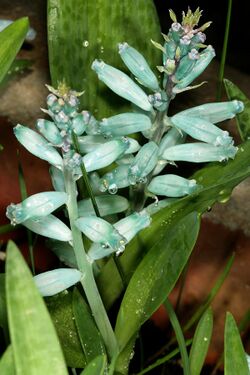Biology:Lachenalia viridiflora
| Lachenalia viridiflora | |
|---|---|

| |
| Scientific classification | |
| Kingdom: | Plantae |
| Clade: | Tracheophytes |
| Clade: | Angiosperms |
| Clade: | Monocots |
| Order: | Asparagales |
| Family: | Asparagaceae |
| Subfamily: | Scilloideae |
| Genus: | Lachenalia |
| Species: | L. viridiflora
|
| Binomial name | |
| Lachenalia viridiflora W.F.Barker[2]
| |
Lachenalia viridiflora, commonly known as the green-flowered Cape cowslip or turquoise hyacinth,[3][4] is a species of flowering plant in the asparagus family native to the southwest Cape Provinces of South Africa.[5] It was discovered in the 1960s, and first described in 1972 by Winsome Fanny Barker.[6]
Description
Lachenalia viridiflora is a bulbous species of perennial plant that grows 8-20cm tall.[7] Each plant grows two leaves, which may be plain or with dark spots.[3] In the winter, plants produce racemes of tubular turquoise flowers with white tips;[3] it is for this reason that Barker chose the specific epithet 'viridiflora', which is Latin for green-flowered.[6] The flowers are pollinated by the lesser double-collared sunbird.[6]
Habitat and distribution
Lachenalia viridiflora is endemic to the Vrendenburg Peninsula, where there are two extant sub-populations.[1] It grows in full sun on granite outcrops in sandy soil which becomes waterlogged in the winter.[6][7] Lachenalia viridiflora is an endangered species, and is threatened by habitat loss and overgrazing.[1]
Cultivation
Lachenalia viridiflora is cultivated as a garden ornamental, and has gained the Royal Horticultural Society's Award of Garden Merit.[3] Plants can be propagated through somatic embryogenesis,[8] leaf cuttings, and by sowing seeds.[6]
References
- ↑ 1.0 1.1 1.2 "Lachenalia viridiflora". South African National Biodiversity Institute. http://redlist.sanbi.org/species.php?species=3814-115.
- ↑ J. S. African Bot. 38: 179 (1972)
- ↑ 3.0 3.1 3.2 3.3 "Lachenalia viridiflora green-flowered Cape cowslip". The Royal Horticultural Society. https://www.rhs.org.uk/Plants/107869/Lachenalia-viridiflora/Details. Retrieved 8 November 2020.
- ↑ "Turquoise hyacinth". Trustees of the Royal Botanic Gardens, Kew. https://temperate.house/plant/turquoise-hyacinth/.
- ↑ "Lachenalia viridiflora W.F.Barker". Board of Trustees of the Royal Botanic Gardens, Kew. 2017. http://powo.science.kew.org/taxon/urn:lsid:ipni.org:names:537270-1.
- ↑ 6.0 6.1 6.2 6.3 6.4 Duncan, Graham (June 2003). "Lachenalia viridiflora". South African National Biodiversity Institute. http://pza.sanbi.org/lachenalia-viridiflora.
- ↑ 7.0 7.1 "Lachenalia viridiflora W.F.Barker". http://worldfloraonline.org/taxon/wfo-0000685556.
- ↑ Kumar, Vijay; Moyo, Mack; Van Staden, Johannes (2016-11-01). "Enhancing plant regeneration of Lachenalia viridiflora, a critically endangered ornamental geophyte with high floricultural potential" (in en). Scientia Horticulturae 211: 263–268. doi:10.1016/j.scienta.2016.08.024. ISSN 0304-4238. https://www.sciencedirect.com/science/article/abs/pii/S0304423816304241.
Wikidata ☰ Q15520595 entry
 |


